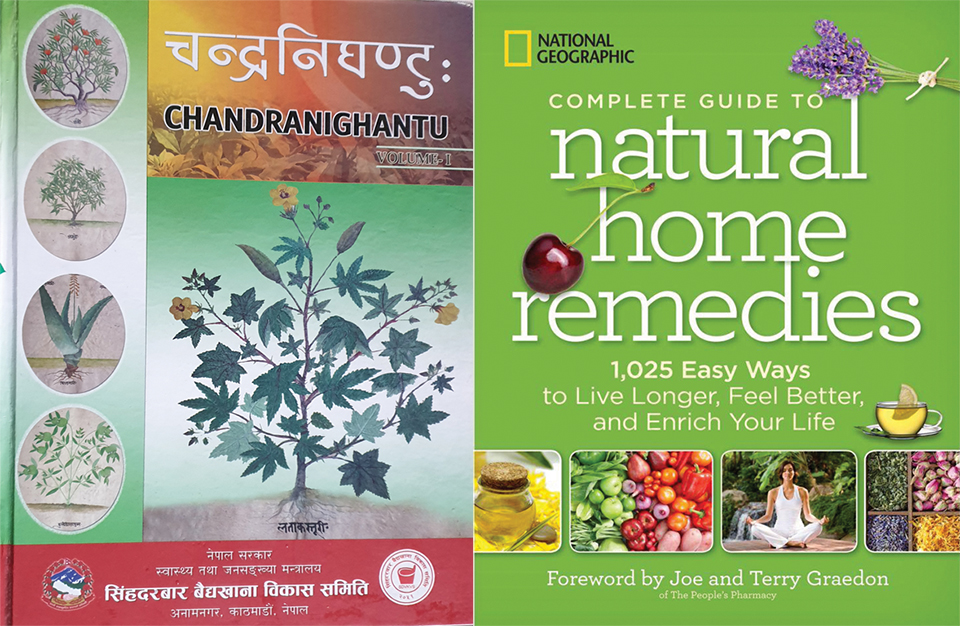
OR

Garlic has antibacterial, antivirus, antifungal, and antioxidant properties and nutrients. For this reason, garlic soup is used by many people to get rid of common cold
During the last two months, I read two books on natural medicine. The first was Chandra Nighatu published by Singha Durbar Vaidhyakhana (Nepal) and the second was Complete Guide to Natural Home Remedies published by National Geographic. Both books are based on extensive research on use of plants and spices. More importantly, both show that if we pay attention to the healing power of commonly available plants and spices, we can be healthy and also avoid and cure common illnesses. For example, medicinal properties of ginger (aduwa), garlic (lasun), and onion (pyaj) are well documented in both books.
Complete Guide gives a detailed accounting of the use of garlic, onion, and ginger in the past. In fact, humans have used these spices for the last 5000 to 7000 years. The book provides practical tips on how to use them in soup, breads, tea etc to prevent and treat common ailments. Chandra Nighatu has beautiful pictures of plants and spices along with their medicinal properties. One drawback in this book is that even though it is intended for a Nepali audience, it does not explain how these ingredients can be used in a typical Nepali kitchen.
I really enjoyed reading these books as they provided practical and helpful knowledge. This knowledge would give health workers confidence to disseminate information in local communities, especially in rural areas where access to modern medicine is not always easy. They emphasize the medicinal and nutritional value that has been ignored. Fortunately, now modern medicine has started to research the beneficial properties of plants. World Health Organization (WHO) has pointed out that 80 percent of population worldwide relies on herbal medicine for some aspects of primary health care. WHO also mentions that “21,000 plant species have the potential for being used as medicinal plants.” These plants/spices can easily be grown in our gardens. Though they can be powerful medicine, they do not have harmful side effects.
I remember how my grandmother used to cook jaulo (mixture of rice and lentils with garlic and fenugreek) when children used to suffer from diarrhea. Even though she may not know the scientific composition of garlic and fenugreek, she knew from her own experience that jaulo was a very healthy meal, something that her own mother and grandmother had relied on.
Now in modern medicine, garlic capsule is used as medicine and it is known that garlic has antibacterial, antivirus, antifungal, and antioxidant properties and nutrients like vitamins B1, B6, and vitamin C, manganese, calcium, copper and selenium. For this reason, garlic soup is used by many people to get rid of common cold. I personally use garlic for fried rice, chatni and lentils.
In Nepal and India, Tulsi (basil) has religious meaning, and many Hindus believe it to be a reincarnation of Lord Vishnu. Now modern medicine has discovered that basil has the ability to help the body fight cancer. Studies published in the journal of Nutrition and Cancer show that basil contains phytochemicals that can help our bodies prevent cancer. Though research into basil is still ongoing, many people already use this plant to make tea/sherbet and it is also available in capsule. Basil leaves help boost our immunity. So our grandmothers were right when they said ‘in every house, there should be one basil plant and it should be worshiped,’ which I now understand to mean that we should take care of this valuable plant.
Complete Guide also discusses beans and lentils that are mostly used in our kitchen. Beans are actually the seeds of legumes, which are among the oldest cultivated plants. In many Nepali homes, kidney bean (Rajmaa), black beans (kaalo simi) and other lentils (dal) are cooked daily. It is one of the main sources of protein, especially for vegetarians. Black or red beans cooked in iron pot and fried with garlic is favorite among many. It tastes good and also provides iron, fiber, protein etc. The book suggests that beans should be soaked for six to eight hours. All cooks in Nepal have been doing this to make sure that it cooks easily, but only a few of us know that the gas-causing substances in beans also leech out during soaking.
There are many recipes in Complete Guide. In Chandra Nighatu, there are no recipes but there is vast knowledge of our common plants, vegetables with beautiful pictures. Many ancient Ayurvedic texts have helpfully documented and preserved this knowledge for future generations.
We need to further preserve such knowledge, transfer it to future generations. Some of the plants we grow are vital source of medication and nutrition.
arunauprety@yahoo.ca
You May Like This

Whose Media Council?
Drop the draft bill, don’t even consider revising it. Rather, force the media community to form their own independent... Read More...

Erosion of reason
Why cannot Nepali intellectual community give a clear opinion on pressing political issues? What has led to this intellectual slackening? Read More...

Think beyond training
Continuing professional development method is slowly being recognised in Nepal as a key motivator for teachers to develop their skills... Read More...









Just In
- Forced Covid-19 cremations: is it too late for redemption?
- NRB to provide collateral-free loans to foreign employment seekers
- NEB to publish Grade 12 results next week
- Body handover begins; Relatives remain dissatisfied with insurance, compensation amount
- NC defers its plan to join Koshi govt
- NRB to review microfinance loan interest rate
- 134 dead in floods and landslides since onset of monsoon this year
- Mahakali Irrigation Project sees only 22 percent physical progress in 18 years










Leave A Comment